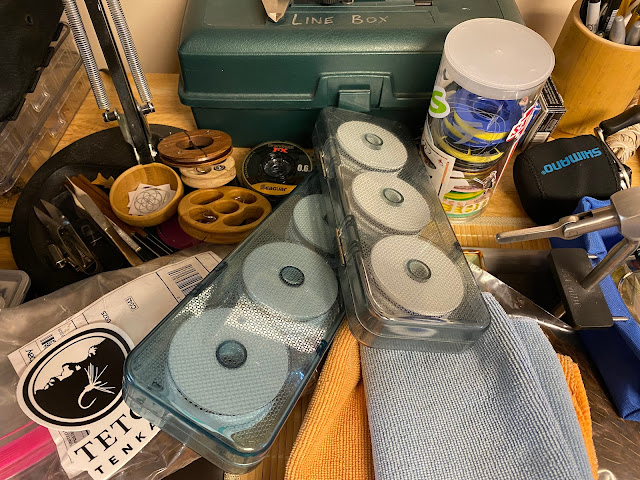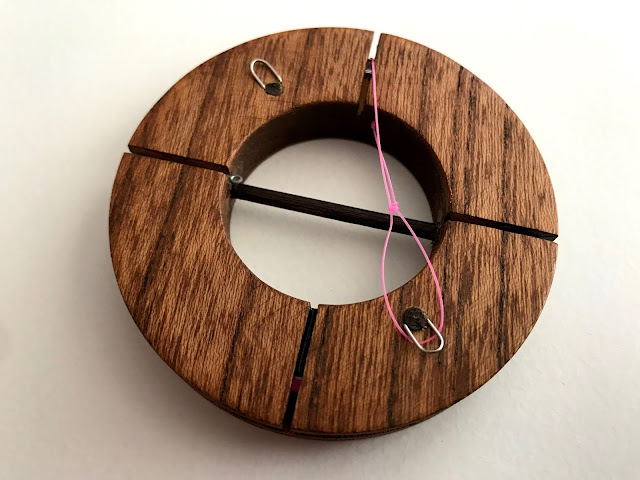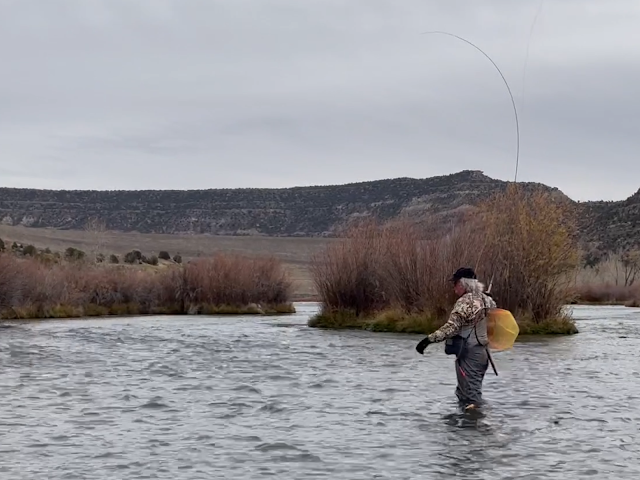Light Line Fly Fishing is what interested me the most in fishing and ultimately lead me to tenkara. Why would I want to write a fly fishing piece on a tenkara site?
Because the two go hand in hand.
Tenkara is fly fishing, but it is different.
Lite line fly fishing, you can do everything you can do with a tenkara rod. I can see some of you immediately object and that's ok but hear me out, you can reach, just not as well, you can sasoi, just not as well but you cannot shoot a fly in a tunnel or let a big fish run, the obvious things, like you can with a fly rod.
Both have merit yet this is not about which one is better, this is about the small streams you fish and it is a rare look where both disciplines live in harmony.
Since day one for me, in 2009, fly fishing and tenkara have lived in unison. I was introduced to tenkara by an American company that said, "sell your fly rod and get into tenkara!"
Hell no, they got it wrong that day and never recovered. I ended up working for that company and it was a great experience. I always advised the group that fly fishing and tenkara were friends, brothers if you will and hand in hand they should exist. I advised the company NOT to engage with fly fisher people negatively and for the most part, bridges were mended instead of being burned, I'm proud of my association with them but that's water under the bridge, let me explain.
I didn't trust anyone outside of Japan to teach me anything about tenkara. I am capable of critical thinking on my own, I've always learned to go to the source and study, trusting my look at from a balanced standpoint. If I don't like something, I don't give it time, I don't engage or debate, that's far too much energy spent on the wrong thing.
So I decided to go to Japan and find out about tenkara on my own. I went in 2013, I was scheduled to go before but the Tohoku earthquake and subsequent tsunami prevented me from visiting the country while it was in duress. I continued to work with the Japanese and I visited my friend Satoshi Miwa, a humble fly fisher that wasn't interested in doing tenkara but he was quite helpful in my study of it. I had been introduced to the works of Yuzo Sebata and Kazuya Shimoda, expert tenkara fishers experienced with fly fishing. I had this idea in my mind that the Japanese loved fly fishing like we do in the West yet tenkara, born in Japan was Japan's contribution to the World of Fly Fishing. I had formed this opinion while reading old tenkara books, watching videos from Japanese home pages and as I wrote above, in my writings, detailed how tenkara is "Japanese style fly fishing" not in the sense that it is a discipline that should substituted for fly fishing but is an adjunct to it.
I had to learn tenkara, not a blend of fly fishing and tenkara or tenkara with a fly fisher's spin (pun intended) so I just quit fly fishing for more than a decade and dove right in and surrounded myself with the best tenkara fishers, media and friends that I could.
I feel like I did a good job.
Now I have returned to fly fishing while still retaining the freedom to choose what I want to do, the way that I want to fish.
Many fly fisher people are not interested in tenkara and that's ok. I would say that they are ignorant, but it just isn't true. Fly fishing is pretty complete as it is yet they do not know how to make the fly dance as a tenkara fisher can.
So I show them and more times than not, I've introduced someone new to tenkara.
If you have been following along, genryu is the headwaters, keiryu is mountain stream fishing and honryu is mainstream fishing. All three can be done with a tenkara rod and or a fly rod. The term keiryu is simply, mountain stream fishing whereas genryu is a specialized area focused on the headwaters of the stream and honryu is the mainstream or river. A tenkara rod works best for keiryu and genryu and we can make it work for honryu. A specialized fly rod designed for each area works very well or a 7' - 8" 1-weight will work well for genryu and keiryu, for rivers, a slightly longer rod really works well. For honryu, tenkara rods are designed to work but there is a compromise in there somewhere whereas with a fly rod, they are much better suited.
You can do everything with a fly rod that a tenkara rod can do but not the other way around.
Yes, of course, there are exceptions but that's not where this article will focus on.
Prior to 2009, my specialty was 1-weight fly rods.
If I were to suggest a fly rod to someone new to fly fishing, I would tell them what I've been telling many of you who I have helped into fly fishing, get a 9' 5-weight and go film yourself casting in the front lawn, watch videos and befriend a fly fisher and go to the river with them. A 5-weight line is like rope to those of us who fish level lines. That's an average line weight and as far as the rod length goes, that's a majority of the rod lengths as well. You can use that rod almost everywhere, light salt water, float tubing, rivers, streams, it works. If you continue on as the years go, I think you may end up like me with a 7' - 8' 1-weight.
Why?
The 1-weight is a light line specialty rod that has been accepted as a specialty. It's not a proprietary line weight such as a 0, 00 or even the 000-weight rod. One company went in that direction and as far as a capable rod, they are however, you are locked into THAT company and what they offer. Many companies offer a 1-weight and it is by far, the lightest and most produced configuration of the industry. You could make the same argument for say a 2-weight or even a 3-weight but those rods are NOT the lightest line weight somewhat readily available whereas the 1-weight line, which is actually what this is about is produced by several fly line companies and has stood the test of time.
I know many of you are waiting for Euro-nymphing to be mentioned, here it is. Euro-nymphing is a conglomeration of techniques, a specialty of subspecialties. It is a frankenfishing, a conglomeration of techniques type genre and without giving a class on Euronymping, I am going to center my thoughts here on conventional (yet specialized) fly fishing without going in a direction of opinion. Euro nymphing is popular. So are bad politicians and that's enough on that topic.
I've seen 1-weight fly rods range from 5'6" to 9'. I've used 1-weight rods in those lengths and have come to the conclusion that a rod of 7'6" to 8' is the sweet spot. It will do the most and is the configuration that I choose in order to maximize what I want out of a 1-weight. On the topic of length, a short fly rod will do almost everything a long rod will except manipulate a line once cast. The short length degrades the ability to mend line in a stealthy manner and in addition, as the length of the rod goes shorter, from my experience, in order to make that short rod (5'6" to 6'6") I have to go up in line weight in order to get the performance I desire from that length fly rod.
I have a whole other subspecialty on short fly rods that I could draw from but what I'm trying to do here is to divorce the tenkara specialty person from a "tenkara only" outlook and marry him or her to the idea of a broader sense of lite line fly fishing that keiryu is.
At one point in my history of fishing 1-weights, I hunted big fish. I'm not proud of that time, I did learn a lot about catching but it took me away from why I enjoy fishing. I found that it addictive and once I began to zero in on big fish, that's all I wanted and that's not the reason why I enjoy fly fishing.
My project here is not to teach you but to share in what I do.
My experience with lite line fly fishing is that it is not un-common. Japanese fishers enjoy fly fishing more than tenkara. In Japan, tenkara is not popular like fly fishing or conventional tackle configurations with spin and bait cast rods made for keiryu. As I wrote above, on my first trip to Japan, I visited with a fly-fishing friend who toured the different watersheds in the central alps. We did a trip based on his small stream fly fishing, yet I fished side by side and we caught just about the same amount and type of fish. Miwa san wrote an article on our trip, "American Tenkara Fisher, Japanese Fly Fisher" and described his experience fishing with me.
So, my experience is to suggest that 9' 5-weight to you. It will be easy to cast and to learn the different techniques in fly fishing but if you want a rod that lives in the same keiryu environment as does tenkara, I suggest a 8' 1-weight. It may take you some time to get there but once you do, we can talk.
Take care and enjoy fishing your way.















































